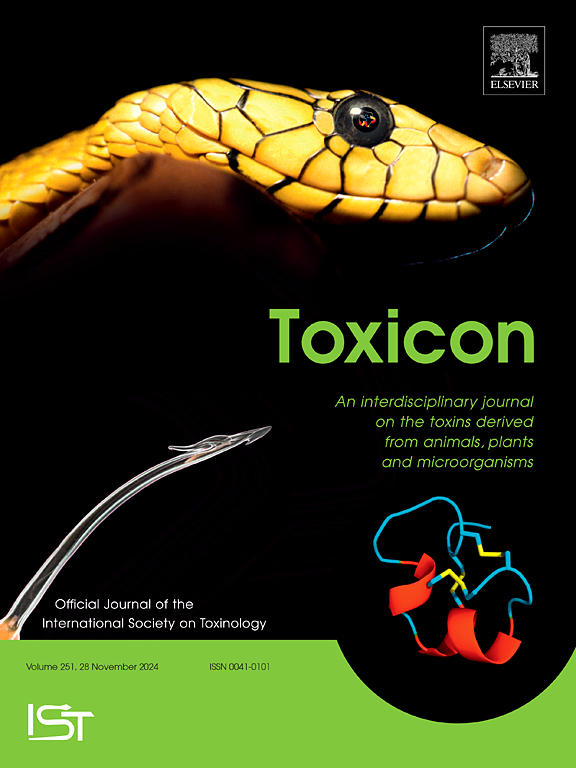从水母多肽中提取金属蛋白酶(MMPs)和磷脂酶的潜在抑制剂:计算机药代动力学和分子对接研究
IF 2.6
4区 医学
Q2 PHARMACOLOGY & PHARMACY
引用次数: 0
摘要
水母蜇伤,特别是来自野水母的蜇伤,由于其毒液毒素如金属蛋白酶(MMPs)和磷脂酶A2 (PLAs A2),会造成严重的健康风险。这种毒素会引起严重的反应,如疼痛、组织坏死、炎症,在极端情况下还会导致心脏骤停。虽然毒性的确切机制尚不完全清楚,但已知MMPs和PLA2酶对组织损伤和炎症有重要作用。因此,抑制这些毒素可以降低毒液毒性,为水母中毒提供新的治疗选择。本研究利用药物信息学方法,对野村线虫衍生肽对野村线虫毒液毒素(金属蛋白酶和磷脂酶)的抑制作用进行了评价。在分析了吸收、分布、代谢、排泄和毒性(ADMET)参数后,选择DN26779_N和DN26779_Q两个肽段进行对接分析。DN26779_N对金属蛋白酶(-13.3)和磷脂酶(-12.6)的结合能均高于DN26779_Q。分子动力学模拟证实了这些由疏水亲和和氢键驱动的相互作用的稳定性。总之,DN26779_N和DN26779_Q显示出作为金属蛋白酶和磷脂酶A2抑制剂的显著潜力,为治疗和解决水母中毒提供了有希望的治疗途径。本文章由计算机程序翻译,如有差异,请以英文原文为准。
Potential inhibitors of metalloproteinases (MMPs) and phospholipases from Nemopilema nomurai jellyfish peptides: An in-silico pharmacokinetics and molecular docking studies
Jellyfish stings, especially from Nemopilema nomurai, pose serious health risks due to its venom toxins like metalloproteinases (MMPs) and phospholipases A2 (PLAs A2). Thes toxin can induce severe reactions such as pain, tissue necrosis, inflammation, and in extreme cases, cardiac arrest. While the exact mechanisms of toxicity are not fully understood, MMPs and PLA2 enzymes are known to contribute significantly to tissue damage and inflammation. Thus, the inhibition of these toxins could reduce venom toxicity and provide new treatment options for jellyfish envenomation. This study utilized pharma informatic to evaluate Nemopilema nomurai jellyfish-derived peptides against Nemopilema nomurai venom toxins (metalloproteinase and phospholipase). After profiling absorption, distribution, metabolism, excretion, and toxicity (ADMET) parameters, two peptides, DN26779_N and DN26779_Q, were selected for docking analysis. DN26779_N exhibited higher binding energy to metalloproteinase (−13.3), and phospholipase (−12.6) than DN26779_Q. Molecular dynamics simulations confirmed the stability of these interactions, driven by hydrophobic affinity and hydrogen bonding. Overall, DN26779_N and DN26779_Q demonstrate significant potential as inhibitors of metalloproteinase, and phospholipase A2, presenting promising therapeutic avenues for treating and addressing jellyfish envenomation.
求助全文
通过发布文献求助,成功后即可免费获取论文全文。
去求助
来源期刊

Toxicon
医学-毒理学
CiteScore
4.80
自引率
10.70%
发文量
358
审稿时长
68 days
期刊介绍:
Toxicon has an open access mirror Toxicon: X, sharing the same aims and scope, editorial team, submission system and rigorous peer review. An introductory offer Toxicon: X - full waiver of the Open Access fee.
Toxicon''s "aims and scope" are to publish:
-articles containing the results of original research on problems related to toxins derived from animals, plants and microorganisms
-papers on novel findings related to the chemical, pharmacological, toxicological, and immunological properties of natural toxins
-molecular biological studies of toxins and other genes from poisonous and venomous organisms that advance understanding of the role or function of toxins
-clinical observations on poisoning and envenoming where a new therapeutic principle has been proposed or a decidedly superior clinical result has been obtained.
-material on the use of toxins as tools in studying biological processes and material on subjects related to venom and antivenom problems.
-articles on the translational application of toxins, for example as drugs and insecticides
-epidemiological studies on envenoming or poisoning, so long as they highlight a previously unrecognised medical problem or provide insight into the prevention or medical treatment of envenoming or poisoning. Retrospective surveys of hospital records, especially those lacking species identification, will not be considered for publication. Properly designed prospective community-based surveys are strongly encouraged.
-articles describing well-known activities of venoms, such as antibacterial, anticancer, and analgesic activities of arachnid venoms, without any attempt to define the mechanism of action or purify the active component, will not be considered for publication in Toxicon.
-review articles on problems related to toxinology.
To encourage the exchange of ideas, sections of the journal may be devoted to Short Communications, Letters to the Editor and activities of the affiliated societies.
 求助内容:
求助内容: 应助结果提醒方式:
应助结果提醒方式:


